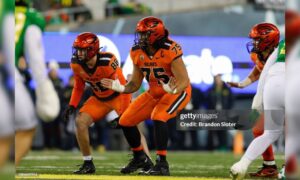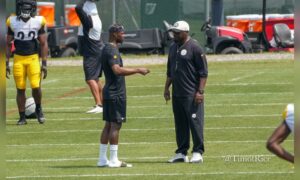By Christina Rivers
A decade of big-target receivers could change how teams choose and train their defensive backs. Everyone talks about Larry Fitzgerald at 6\’3″ (218), and Calvin Johnson at 6\’5″ (236) isn\’t surprisingly named after one of the tallest Transformers (Megatron). It isn\’t just their height that is imposing, but their athletic ability. Forget about JurassicPark; these guys are the Terror-dactyls of the NFL. With tall receivers filling rosters across the league, organizations and defensive coordinators are left scrambling to find cornerbacks who can not only keep up speed-wise, but have enough height and vertical leap to shut big receivers down. My advice: stop asking for bigger corners.
According to Sports Illustrated, only 11 full-time starting wideouts stood at 6\’3″ or more in 2001. Plaxico Burress was the lone receiver who topped out at 6\’5″ at the time. In 2011, the number skyrocketed to 20; four players at 6\’4″ and six at 6\’5″.
The premium pick at the receiving position has evolved, and the 2011 and 2012 NFL Drafts reflected the fact that the trend of grabbing up tall receivers with big wing spans isn\’t likely to change any time soon.
In 2011, A.J. Green was selected in the first round (4th overall) by the Cincinnati Bengals. Julio Jones (Atlanta Falcons – 6th overall) and Jonathan Baldwin (Kansas City Chiefs – 26th overall) followed in the same round.
During this year\’s NFL Draft, Michael Floyd (Notre Dame), Stephen Hill (Georgia Tech) and Alshon Jeffrey (South Carolina) all measured 6\’3″ or more. Two top-ten prospects were 6\’2″ tall. Justin Blackmon (Oklahoma State) came in at 6\’1″ with a 78 1/2 inch wing span and a history for being very physical.
During the 1990s, tall receivers traditionally were used to stretch the field. Athletic corners who were under or near 6\’0″ used speed to remain competitive. They read routes and learned to get off the line in order to disrupt those routes. On short plays, physical corners who lacked height found success by reading quarterbacks and jamming receivers who wanted to cross the middle or do a short up-and-out.
In 2011, only seven starting cornerbacks were 6\’2″ or taller. That included Brandon Browner of the Seattle Seahawks. In the 2012 Draft class, three of the top ten prospects at corner were 6\’0″ or taller – Dre Kirkpatrick (6014 – Alabama), Trumaine Johnson (6020 – Montana) and Stephon Gilmore (6004 -South Carolina).
A little sports psychology may need to be implemented here. A corner has to appear bigger and more aggressive, even if the receiver he\’s covering is four inches taller. Corners who have the size need to develop the ability to play press or \’off\’ coverage to gain a step and advantage. Agility and athleticism is going to redefine the defensive back position unless more high school and college coaches can get guys with speed and height into their football programs and interested in defending balls instead of catching the pass from the quarterback for a score (and trust me, an interception can be just as exciting as a touchdown catch).
The opportunity for change is there (hint to speedy tall guys who don\’t really enjoy basketball or volleyball), but I don\’t think it\’s necessary to change height in defensive backs.
This isn\’t to discount current NFL cornerbacks in any way. Coaches aren\’t likely to complain if their 5\’10” corner grabs an interception (takeaway) over an opponent\’s 6\’3″ receiver. That coach is likely going to be ecstatic.
It would be unrealistic and untrue to say that a 6\’0″ cornerback can\’t run step-for-step down field with a taller receiver. How many times have we seen aggressive defensive backs limit a \’hot\’ receiver and change the offensive plan of their opponent. I can think of several games when that exact thing happened.
Coaches and scouts may be salivating over and coveting bigger corners, but the NFL has been looking for bigger and faster guys for quite some time now. If I were a coach, however, I\’d accept a cornerback or two that understand and think like receivers. I would want high-intensity, tenacious corners who have a refuse-to-back-down attitude and who have no problem covering the field. If my 5\’11” corner could stay with Fitzgerald or Johnson and be physically demanding – strong tackling skills and ability to wrap up or even bat the ball away – I\’d play him every game.
I don\’t want my corners to bite on every pump fake or hip-swinging juke by a sneaky receiver. I want him to have a head of steam, good hands and watch plenty of game film. Then I want him to go out on the field and think he\’s the biggest dog on the turf. Even if he gets beat, I want him right back on his feet barking and ready to tear into the next play like it\’s a t-bone.
Watch for the \’tall\’ trend to continue at both receiver and defensive back positions as the question of height is talked about over and over again by analysts, coaches, etc. Meanwhile, I\’d pay attention to the corners who play smarter because they are mentally prepared and buck that system.
How do the Steelers cornerbacks measure up?
Ike Taylor – 6\’2″ (195) – 10th year (Louisiana-Lafayette)
Cortez Allen – 6\’1″ (196) – 2nd year (The Citadel)
Keenan Lewis – 6\’0″ (208) – 4th year (Oregon State)
Curtis Brown – 6\’0″ (185) – 2nd year (Texas)
(New roster additions)
Terry Carter – 5\’10” (184) – R – Louisiana Tech
Terrence Frederick – 5\’10” (187) – R – Texas A&M
Andre Freeman – 5\’11” (188) – R – Slippery Rock
Walter McFadden (listed as a DB) – 5\’10” (180) – 2nd year -Auburn







